
Largest town and capital of the Drenthe province. It emerged in the 17th century around the premises of a closed convent which had become the seat of the provincial government shortly after 1600. In 1809 Assen was the second place in Drenthe, after Coevorden, to receive city rights.
Grootste stad en hoofdstad van de provincie Drenthe. De plaats ontstond in de 17e eeuw rond de gebouwen van een voormalig klooster dat kort na 1600 de zetel van het provinciale bestuur werd. In 1809 kreeg Assen als de tweede plaats in Drenthe, na Coevorden, stadsrechten.
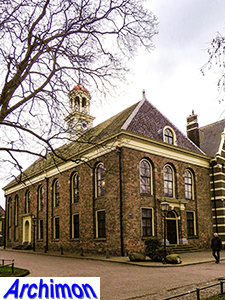 The
Abdijkerk
('abbey church') was built as a Romanesque church in the 13th century and was
turned into a ruin in 1601 when its tower collapsed. Only the southern wall is
still original. In 1664 the church was rebuilt as a protestant church. After 1848
it had several profane destinations since and is now part of a museum.
The
Abdijkerk
('abbey church') was built as a Romanesque church in the 13th century and was
turned into a ruin in 1601 when its tower collapsed. Only the southern wall is
still original. In 1664 the church was rebuilt as a protestant church. After 1848
it had several profane destinations since and is now part of a museum.Location: Brink 2
De Abdijkerk ('abdijkerk') is van oorsprong een romaanse kerk, gebouwd in de 13e eeuw en in 1601 door het instorten van de toren veranderd in een ru´ne. Alleen de zuidelijke muur is nog origineel. In 1664 werd de kerk herbouwd als een protestantse kerk. Sinds 1848 had het gebouw een aantal profane bestemmingen, meest recent als onderdeel van een museum.
Locatie: Brink 2
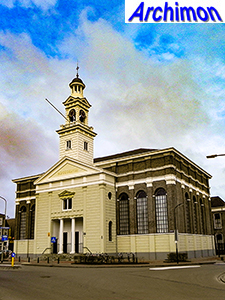
The reformed Grote Kerk, nowadays called
Jozefkerk, is a big church in Neo-Classical
style. It was designed by C.J. Spaan and built in 1848. The original lantern was
destroyed by fire in 1910. It was replaced by a slightly different one, designed
by P.M.A. Huurman.
Location: Kerkplein 1
De hervormde Grote Kerk, tegenwoordig
Jozefkerk genaamd, is een grote kerk in neoclassicistische stijl. De kerk werd
ontworpen door C.J. Spaan en gebouwd in 1848. De oorspronkelijke lantaarn werd
in 1910 door brand verwoest. Zij werd vervangen door een nieuwe in iets
aangepaste vormen, ontworpen door P.M.A. Huurman.
Locatie: Kerkplein 1
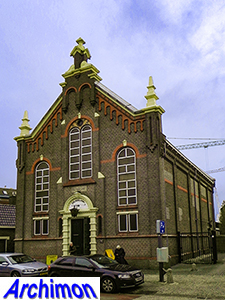
The former synagogue, now Christelijke
Gereformeerde Kerk, was built in 1901. It was designed by J. Smallenbroek in an
eclectic style with Neo-Renaissance influences.
Location: Groningerstraat 14
De voormalige synagoge, nu Christelijke
Gereformeerde Kerk, werd gebouwd in 1901. Het gebouw werd ontworpen door J.
Smallenbroek in een eclectische stijl met neorenaissance invloeden.
Locatie: Groningerstraat 14
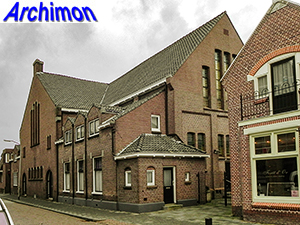
The Geref. Noorderkerk was built in
Neo-Classical style by a design by H. Winters in 1876. However, it was later
drastically rebuilt by J. Smallenbroek and is now in
Rationalist
style.
Location: Oude Molenstraat 20
De Geref. Noorderkerk
werd gebouwd in neoclassicistische stijl naar een ontwerp van H. Winters in
1876. Het gebouw werd echter later drastisch verbouwd door J. Smallenbroek en is
sindsdien in rationalistische stijl.
Locatie: Oude Molenstraat 20
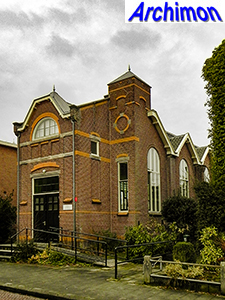
The Mennonite church was built in 1909
by a design by townarchitect T. Boonstra in a style related to Jugendstil.
Location: Oranjestraat 13
De Doopsgezinde kerk werd gebouwd in 1909 door een ontwerp van
stadsarchitect T. Boonstra in een stijl die verwant is aan Jugendstil.
Locatie: Oranjestraat 13
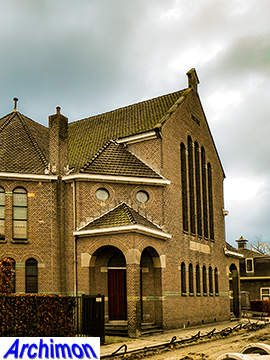
The reformed
chapel was built in 1913, for conservative protestants who had left the
'liberal' Grote Kerk. The chapel is a centralizing church in
Rationalist
style, designed by H. Enklaar. It is now a theatre.
Location: Oosterhoutstraat 5
De hervormde kapel werd gebouwd in
1913, ten behoeve van conservatieve protestanten die zich van de 'vrijzinnige'
Grote Kerk hadden afgescheiden. De kapel is een centraalbouw in rationalistische
stijl, ontworpen door H. Enklaar. Het is nu een theater.
Locatie: Oosterhoutstraat 5
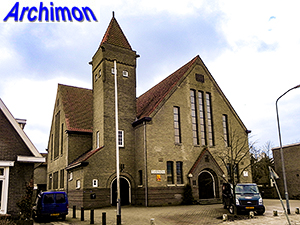
The Geref. Zuiderkerk was built in
1923-1925 and was designed by local architect A. Smallenbroek in a moderate
Expressionist
style.
Location: Zuidersingel 79
De Geref. Zuiderkerk
is gebouwd in 1923-1925 en werd ontworpen door de plaatselijke architect A.
Smallenbroek in een gematigde expressionistische stijl.
Locatie: Zuidersingel 79
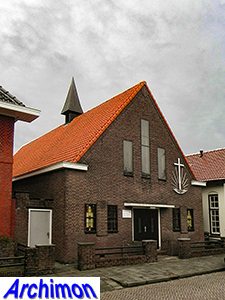
Also in moderate Expressionist style is the New Apostolic church, a small aisleless building built in 1925.
Location: Prins Hendrikstraat 1b
Eveneens in een gematigde expressionistische stijl is de Nieuw Apostolische Kerk, een klein eenbeukig gebouw uit 1925.
Locatie: Prins Hendrikstraat 1b

The catholic O.L.
Vrouwe ten Hemelopneming is an aisleless church in
Traditionalist
style, designed by J.G.A. van Dongen
and built in 1933-1934.
Location: Dr. Nassaustraat 3A
De katholieke O.L. Vrouwe ten Hemelopneming
is een eenbeukige kerk in traditionalistische stijl, ontworpen door J.G.A. van
Dongen en gebouwd in 1933-1934.
Locatie: Dr. Nassaustraat 3A